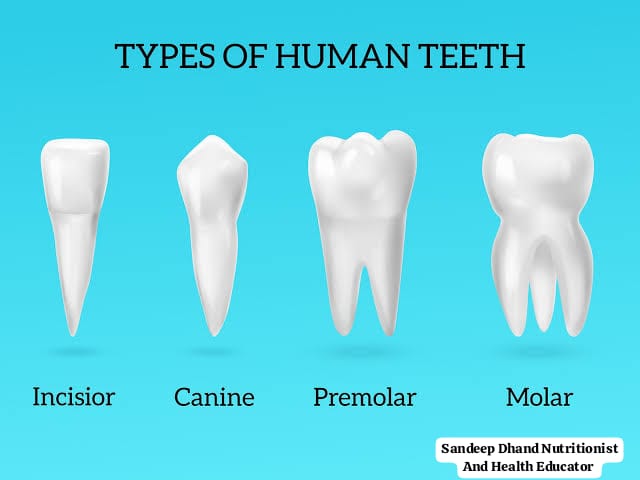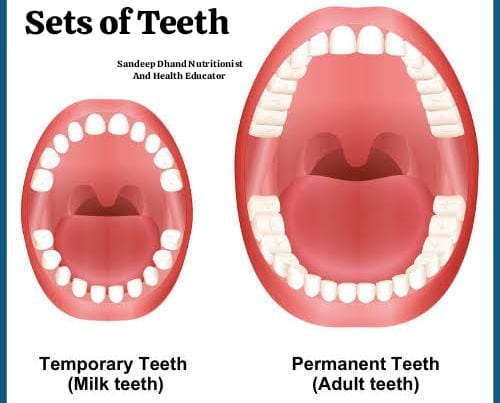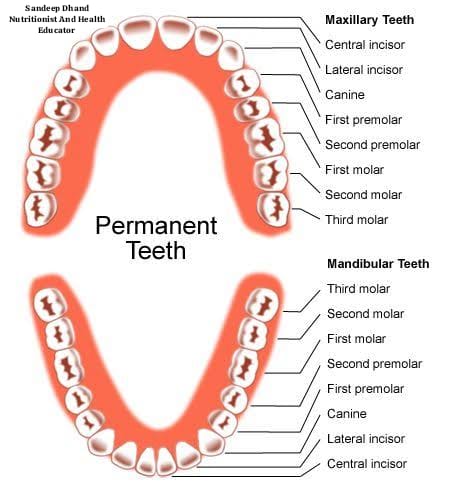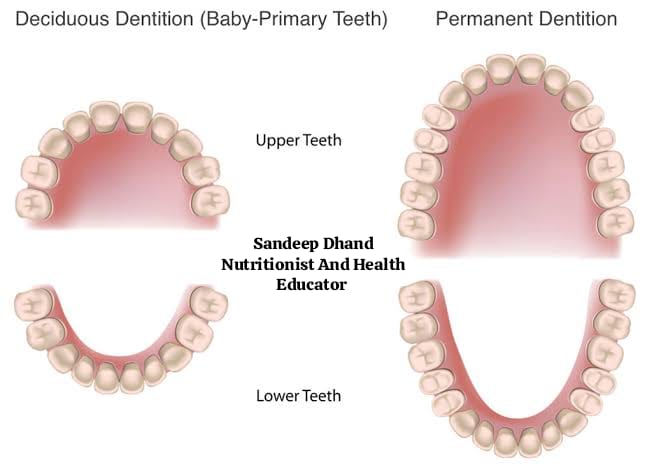Sandeep Dhand
Nutritionist And Health Educator
The human mouth contains 32 permanent teeth, which play a vital role in digestion, speech, and appearance. These teeth are categorized into four types: incisors, canines, premolars, and molars. Each type has a unique structure and function. Below, we’ll explore the details of all 32 teeth, their anatomy, functions, and development.
Overview of Teeth Types and Numbers

Humans have two sets of teeth in their lifetime:

- Primary teeth (baby teeth): 20 in total.
- Permanent teeth: 32 in total, which replace the primary teeth during childhood and adolescence.
The 32 permanent teeth are divided as follows:
8 Incisors (4 upper, 4 lower)
4 Canines (2 upper, 2 lower)
8 Premolars (4 upper, 4 lower)
12 Molars (6 upper, 6 lower, including 4 wisdom teeth)
- Incisors (8 Teeth)
Location
The front teeth, 4 in the upper jaw and 4 in the lower jaw.
Each jaw contains two central incisors and two lateral incisors.
Structure
Shape: Thin and flat with a sharp, chisel-like edge for cutting food.
Roots: Single-rooted, making them less robust than molars or canines.
Function
Cutting and slicing food during the initial stages of chewing.
Crucial for speech and pronunciation, especially for sounds like “f,” “v,” and “th.”
Provide support to the lips and contribute to facial aesthetics.
Eruption Timeline
Central incisors erupt around 6-7 years (lower jaw first).
Lateral incisors erupt around 7-8 years.
Special Features
Central incisors are the most visible teeth and are crucial for a person’s smile.
Lateral incisors are slightly smaller and more pointed than central incisors.
- Canines (4 Teeth)
Location
Found next to the lateral incisors, one on each side in both the upper and lower jaws.
Structure
Shape: Pointed and sharp, resembling fangs.
Roots: Longest roots among all teeth, providing stability and strength.
Function
Tear and shred tough food items like meat.
Maintain the alignment of teeth by guiding them into proper occlusion (bite).
Enhance the shape and contour of the mouth.
Eruption Timeline
Lower canines erupt around 9-10 years.
Upper canines erupt slightly later, around 11-12 years.
Special Features
Known as “cornerstone teeth” because of their strategic position in the dental arch.
Their long roots make them more resistant to damage or loss.
- Premolars (8 Teeth)
Location
Situated behind the canines, with two premolars on each side of the upper and lower jaws.
Structure
Shape: Wider and flatter than canines, with a crown featuring cusps (raised points).
Roots: Typically have one or two roots.
Function
Grind and crush food, transitioning it into smaller particles for easier swallowing and digestion.
Assist molars in breaking down food.
Eruption Timeline
First premolars erupt around 10-11 years.
Second premolars erupt around 11-12 years.
Special Features
Premolars are unique to adult teeth and are not present in the primary (baby) dentition.
Their combination of sharp cusps and flat surfaces makes them versatile for chewing both hard and soft foods.
- Molars (12 Teeth)
Location
Located at the back of the mouth, three on each side of the upper and lower jaws.
Structure
Shape: Large, flat crowns with multiple cusps for effective grinding.
Roots: Upper molars typically have three roots, while lower molars usually have two.
Types of Molars

- First Molars:
Also known as the “six-year molars” because they erupt around age 6.
Largest and strongest molars, used primarily for heavy chewing.
- Second Molars:
Also called “twelve-year molars” as they erupt around age 12.
Slightly smaller than the first molars but still crucial for grinding food.
- Third Molars (Wisdom Teeth):
Erupt between ages 17-25, though they may not fully emerge in some people.
Often removed if they cause crowding, misalignment, or pain.
Function
Crushing and grinding food into tiny particles for easier digestion.
Provide support to the dental arch and maintain facial structure.
Special Features
Wisdom teeth often have unpredictable growth patterns, leading to issues like impaction or misalignment.
Molars are the most robust teeth due to their thick enamel and multiple roots.
Anatomy of a Tooth
Each tooth has the following parts:
- Crown: The visible part above the gumline, covered with enamel.
- Enamel: The hardest, outermost layer, protecting the tooth from decay.
- Dentin: Lies beneath the enamel, providing support and transmitting sensations.
- Pulp: The innermost layer containing nerves and blood vessels.
- Root: Anchors the tooth to the jawbone via the periodontal ligament.
- Gums (Gingiva): Surround and protect the base of the teeth.
Development of Permanent Teeth
- Teeth develop in stages:
Initiation: Formation begins in the jawbone during fetal development.
Calcification: Hard tissues like enamel and dentin form over time.
Eruption: Teeth push through the gums, emerging into the oral cavity.
- Teeth erupt in pairs (one tooth on each side of the jaw).
- The replacement of primary teeth with permanent teeth begins around age 6 and is typically complete by age 13, except for wisdom teeth.
Importance of Proper Dental Care

To maintain the health and functionality of all 32 teeth, proper oral hygiene and dental care are essential:
- Daily Brushing and Flossing:
Use fluoride toothpaste to strengthen enamel and prevent cavities.
Floss daily to remove food particles and plaque between teeth.
- Regular Dental Check-ups:
Visit a dentist every six months for cleaning and evaluation.
Early detection of issues like cavities or gum disease prevents complications.
- Balanced Diet:
Avoid excessive sugar and acidic foods that can erode enamel.
Eat calcium-rich foods to strengthen teeth and bones.
- Protection:
Use a mouthguard during sports to prevent injury.
Avoid habits like teeth grinding or chewing hard objects.
Common Dental Problems and Treatments
- Cavities (Tooth Decay): Caused by plaque buildup. Treated with fillings or crowns.
- Gum Disease (Periodontitis): Inflammation of the gums. Managed with deep cleaning or surgery.
- Tooth Sensitivity: Pain from hot, cold, or sweet foods. Treated with desensitizing toothpaste.
- Wisdom Teeth Issues: Impaction or misalignment. Often resolved through extraction.
Interesting Facts About Human Teeth
- Strongest Substance: Tooth enamel is the hardest substance in the human body.
- Unique to You: Teeth are like fingerprints; no two sets are identical.
- Primary Teeth Fall Out: Children lose their baby teeth between ages 6-12.
- Wisdom Teeth Are Vestigial: They are remnants of human evolution when diets required more chewing.
In summary, the 32 permanent teeth in the human mouth are specialized tools designed for cutting, tearing, grinding, and chewing food, as well as contributing to speech and appearance. Each tooth type plays a unique and vital role, making proper care and regular dental visits crucial for maintaining oral health.
